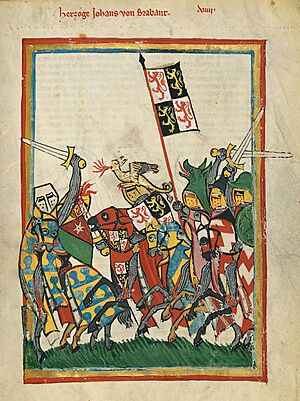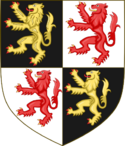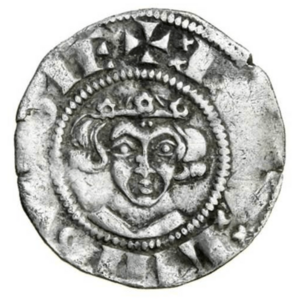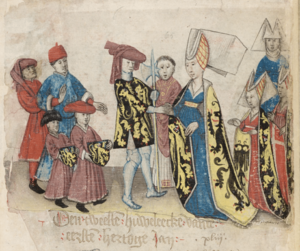John I, Duke of Brabant facts for kids
Quick facts for kids John I |
|
|---|---|

John going to battle, from the Codex Manesse
|
|
| Duke of Brabant and Lothier | |
| Reign | 1267–1294 |
| Predecessor | Henry |
| Successor | John II |
| Duke of Limburg | |
| Reign | 1288–1294 |
| Predecessor | Reginald I of Guelders |
| Successor | John II |
| Born | 1252 |
| Died | 3 May 1294 (aged 41 or 42) |
| Burial | Franciscan Church, Brussels |
| Spouse |
|
| Issue |
|
| House | House of Reginar |
| Father | Henry III, Duke of Brabant |
| Mother | Adelaide of Burgundy |
| Coat of arms |  |
John I, also known as John the Victorious, was an important ruler in the 13th century. He was born around 1252 or 1253 and passed away on May 3, 1294. John I served as the Duke of Brabant from 1267 to 1294. He also became the Duke of Limburg from 1288 until his death. People in the 13th century saw him as a brave and adventurous leader. He was often described as the perfect example of a chivalrous prince.
Contents
The Early Life of Duke John I
John I was born in a city called Leuven. His father was Henry III, Duke of Brabant. His mother was Aleidis of Burgundy. She was the daughter of Hugh IV, Duke of Burgundy. John I also had an older sister, Maria of Brabant. Maria later became the Queen of France by marrying Philip III of France.
In 1267, something important happened. John's older brother, Henry IV, Duke of Brabant, was not able to rule well. Because of this, Henry was removed from his position. John then became the new Duke of Brabant.
John's Military Victories
John I was known for his skills in battle. His biggest military success was the Battle of Worringen in 1288. In this battle, John I won control over the Duchy of Limburg. His army was much smaller than his enemies' forces. However, he led a successful attack into the Rhineland. He managed to defeat a group of allied armies.
After this victory, Limburg officially became part of the Duchy of Brabant. This made John I's territory much larger and stronger.
A Popular and Chivalrous Prince
John I was seen as a great example of a medieval prince. He was brave and loved adventures. He was also very good at many physical activities. People admired his generous spirit and his love for grand events. Many believed he was one of the most talented leaders of his time.
Because of his popularity, John I was often featured in poems and stories from the Middle Ages. Even today, there is a famous song about him. This song is so well-known that it was once considered to be the anthem for the North Brabant region. John I especially enjoyed tournaments and always wanted to join in jousting competitions.
The End of His Reign
On May 3, 1294, John I was at a wedding celebration. This event took place in a town called Bar-le-Duc. During the festivities, he was badly wounded in his arm by a person named Pierre de Bausner. This injury sadly led to his death.
John I was buried in the church of the Order of Friars Minor in Brussels. However, during a time of religious conflict in 1566, his tomb was destroyed. Nothing remains of it today.
John I's Family and Children
John I was married two times during his life.
His first marriage was on September 5, 1270. He married Margaret. She was the daughter of Louis IX of France. They had a son together. Sadly, both Margaret and their baby died shortly after the child's birth.
In 1273, John I married for the second time. His second wife was Margaret. She passed away on July 3, 1285. Margaret was the daughter of Guy, Count of Flanders. John and Margaret had several children together:
- Godfrey (born 1273 or 1274 – died after September 13, 1283).
- John II of Brabant (born 1275 – died 1312). He later became the next Duke of Brabant.
- Margaret (born October 4, 1276 – died December 14, 1311, in Genoa). She married Henry VII, Holy Roman Emperor on July 9, 1292.
- Marie (died after December 2, 1338). She married Count Amadeus V of Savoy.
John I's Lasting Legacy
Duke John I is still remembered today. A popular folk song called Harbalorifa tells his story. This song remains very popular in the Netherlands.
Two well-known Dutch beers are also named after him. The popular beer Hertog Jan takes its name from the duke. Another beer, Primus, from the Haacht Brewery, is also named after John I (Jan Primus).
See also
- Dukes of Brabant family tree
- Hertog Jan



